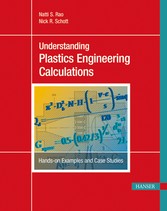Natti S. Rao, Nick R. Schott
Understanding Plastics Engineering Calculations
Hands-on Examples and Case Studies
Table of Contents
6
Preface
10
1 Rheological Properties of Molten Polymers
12
1.1 Polymer Melt Flow
12
1.1.1 Apparent Shear Rate
13
1.1.2 Apparent Viscosity
14
1.1.3 Power Law of Ostwald and De Waele
14
1.1.4 Viscosity Formula of Klein
15
1.1.5 Resin Characterization by Power Law Exponent
16
1.2 Melt Flow Index
18
1.3 Relationship between Flow Rate and Pressure Drop
19
1.4 Shear Rates for Extrusion Dies
21
References.
24
2 Thermal Properties of Solid and Molten Polymers
26
2.1 Specific Volume
26
2.2 Specific Heat
29
2.3 Thermal Expansion Coefficient
30
2.4 Enthalpy
31
2.5 Thermal Conductivity
33
2.6 Thermal Diffusivity
34
2.7 Coefficient of Heat Penetration
35
2.8 Heat Deflection Temperature
36
2.9 Vicat Softening Point
37
References.
39
3 Heat Transfer in Plastics Processing
40
3.1 Steady State Conduction
40
3.1.1 Plane Wall
41
3.1.2 Cylinder
42
3.1.3 Hollow Sphere
42
3.1.4 Sphere
43
3.1.5 Heat Conduction in Composite Walls
43
3.1.6 Overall Heat Transfer through Composite Walls
47
3.2 Unsteady State Conduction
48
3.2.1 Temperature Distribution in One-Dimensional Solids
49
3.2.2 Thermal Contact Temperature
56
3.3 Heat Conduction with Dissipation
58
3.4 Dimensionless Groups
59
3.5 Heat Transfer by Convection
62
3.6 Heat Transfer by Radiation
64
3.7 Dielectric Heating
68
3.8 Fick’s Law of Diffusion
70
3.8.1 Permeability
70
3.8.2 Absorption and Desorption
71
3.9 Case Study: Analyzing Air Gap Dynamics in Extrusion Coating by Means of Dimensional Analysis
72
3.9.1 Heat Transfer Between the Film and the Surrounding Air
73
3.9.2 Chemical Kinetics
74
3.9.3 Evaluation of the Experiments
76
References.
77
4 Analytical Procedures for Troubleshooting Extrusion Screws
78
4.1 Three-Zone Screw
79
4.1.1 Extruder Output
80
4.1.2 Feed Zone
80
4.1.3 Metering Zone (Melt Zone)
82
4.1.4 Practical Design of 3-Zone Screws
89
4.2 Melting of Solids
94
4.2.1 Thickness of Melt Film
94
4.2.2 Melting Profile
98
4.2.3 Melt Temperature
102
4.2.4 Melt Pressure
103
4.2.5 Heat Transfer between the Melt and the Barrel
104
4.2.6 Screw Power
106
4.2.7 Temperature Fluctuation of the Melt
109
4.2.8 Pressure Fluctuation
110
4.2.9 Extrusion Screw Simulations
110
4.2.10 Mechanical Design of Extrusion Screws
118
References.
121
5 Analytical Procedures for Troubleshooting Extrusion Dies
122
5.1 Calculation of Pressure Drop
123
5.1.1 Effect of Die Geometry on Pressure Drop
124
5.1.2 Shear Rate in Die Channels
125
5.1.3 General Relationship for Pressure Drop in Any Given Channel Geometry
125
5.1.4 Examples for Calculating Pressure Drop in the Die Channels of Different Shapes
126
5.1.5 Temperature Rise and Residence Time
134
5.2 Spider Dies
135
5.3 Spiral Dies
140
5.4 Adapting Die Design to Avoid Melt Fracture
141
5.4.1 Pelletizer Dies
143
5.4.2 Blow Molding Dies
143
5.4.3 Summary of the Die Design Procedures
145
5.5 Flat Dies
146
5.6 An Easily Applicable Method of Designing Screen Packs for Extruders
148
5.7 Parametrical Studies
154
5.7.1 Pipe Extrusion
154
5.7.2 Blown Film
157
5.7.3 Thermoforming
160
References.
163
6 Analytical Procedures for Troubleshooting Injection Molding
164
6.1 Effect of Resin and Machine Parameters
165
6.1.1 Resin-Dependent Parameters
165
6.1.2 Mold Shrinkage and Processing Temperature
166
6.1.3 Drying Temperatures and Times
168
6.2 Melting in Injection Molding Screws
168
6.2.1 Model
169
6.2.2 Results of Simulation
172
6.2.3 Screw Dimensions
174
6.3 Injection Mold
174
6.3.1 Runner Systems
174
6.3.2 Mold Filling
177
6.4 Flow Characteristics of Injection Molding Resins
179
6.4.1 Model
180
6.4.2 Melt Viscosity and Power Law Exponent
181
6.4.3 Experimental Results and Discussion
182
6.5 Cooling of Melt in the Mold
185
6.5.1 Thermal Design of the Mold
185
6.6 Mechanical Design of the Mold
193
6.7 Rheological Design of the Mold
195
References.
198
Summary
200
Appendix: List of Programs with Brief Descriptions
202
Index
204
Biography
206
© 2009-2024 ciando GmbH
 Zu Hanser-Fachbuch.de
Zu Hanser-Fachbuch.de
 Warenkorb
Warenkorb
